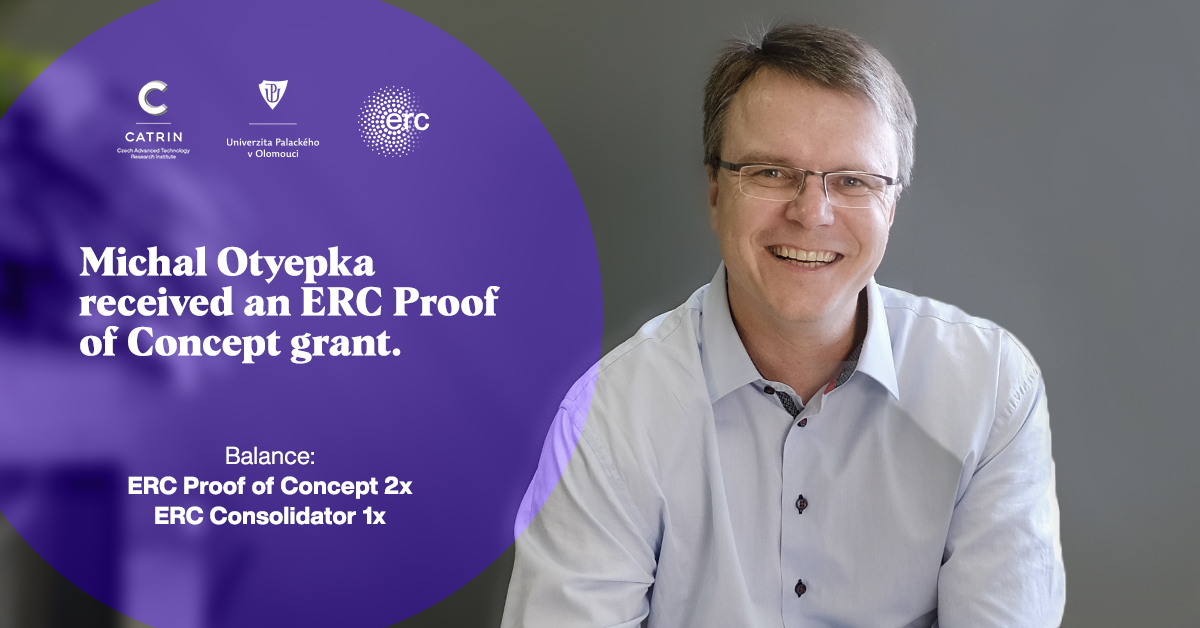Physical chemist Otyepka wins his third ERC grant. It targets lithium-sulfur batteries
The physical chemist Michal Otyepka from the Czech Advanced Technology and Research Institute (CATRIN) of Palacký University Olomouc has succeeded for a second time in the competition for a prestigious grant funded by the European Research Council (ERC). This second project in the Proof of Concept (PoC) category will support translation of basic research findings to practice. Thanks to this, researchers will prepare a sufficient amount of fluorographene-based nanomaterial and in cooperation with a commercial partner will verify its use in lithium-sulfur batteries. As part of this call, ERC PoC grants will be provided to 166 researchers, with one going to the Czech Republic.
While designing the electrode material, the team capitalized upon their rich experience of so-called 2D chemistry, i.e., understanding the chemical rules of the two-dimensional world of ultra-thin carbon nanomaterials. This is the topic of Michal Otyepka’s first ERC-funded research, which started in 2016. Based on this knowledge, his team searched for new, super-functional materials derived from graphene for specific applications. In this case, they chose a simple method and prepared a new sulfur-modified graphene derivative on a laboratory scale, which they submitted to the European Patent Office.

“This simple method could be very effective for production of lithium-sulfur batteries with high performance, stability and long life. We have demonstrated these properties on a laboratory scale. I am very glad that thanks to the ERC Proof of Concept project we will be able to improve the production process and verify the material during industrial testing in real facilities. I also view the project as recognition for the results the team at CATRIN achieved in the field of graphene derivatives,” said Otyepka. The one-year project received a financial support of 150,000 euros.
Lithium-sulfur batteries (LSBs) are one of the options to address the growing demand for energy in relation to the dynamic development of technologies, while reducing dependence on toxic chemicals or raw materials that pollute the environment. Sulfur is an environmentally friendly, easily accessible and affordable material, and batteries containing it dispense with toxic metals such as nickel or cobalt. The fact that LSBs are rechargeable will help reduce the amount of electronic waste in the long run.
However, the disadvantage of sulfur for use in lithium batteries so far has been its low conductivity and leaking during repeated charging/discharging, which led to a rapid reduction in battery capacity. These drawbacks had to be overcome. First, they removed some of the fluorine atoms from the fluorographene and bound polysulphides to the vacant sites with a strong bond. Thanks to their properties, it was possible to connect the individual layers to one other.
“We have formed strong bonds between the carbon backbone of fluorographene and sulfur. This prevents the gradual release of sulphur during the charging and discharging cycles. The material has excellent performance, high capacity and great stability. The fact that the feedstock—a commonly used industrial lubricant—is readily available is also beneficial for practical application,” described the properties one of the authors, Aristides Bakandritsos.
This is not the first time CATRIN scientists have looked for a way to get a new material from a lab into industrial practice. Michal Otyepka won his first ERC PoC grant in 2020, the first ever for the Czech Republic. His goal was to prepare and test one of the graphene derivatives for energy storage in other devices—supercapacitors.
The ERC grants are intended for top researchers across disciplines. The programme is open only to researchers that are currently conducting or have conducted research under the ERC in the past. The Council funds individual investigators and their research teams based on an assessment of the scientific excellence of the project proposal and the investigator. The Proof of Concept call aims to support successful ERC grant investigators at the earliest stage of commercialisation of their research results. The grants are part of the EU research and innovation programme Horizon Europe.
The President of the European Research Council, Maria Leptin, highlighted the fact that the results of frontier research are transferable to practice. “It’s wonderful to see that frontier research has the capacity to generate discoveries that can be quickly put into practice. Let’s not forget that there is no applied research without basic research feeding the pipeline first—and that very valuable innovations spring from all disciplines, from the physical and life sciences to the social sciences and humanities.” she wrote in her letter to the successful applicant of a second ERC PoC.
The Council allocated €25 million for PoC projects in 2021. 348 proposals were submitted, out of which 48 percent succeeded. The highest number of grants (22) go to the UK, followed by Italy, receiving 21, and Spain and Israel with 18 each. Other successful countries are, for example, Austria (7 grants), Belgium (5), Denmark (4), Germany (13), the Netherlands (16), or France (15).
Michal Otyepka
The 47-year-old scientist studied Physical Chemistry at the Faculty of Science of Palacký University. He is dedicated to the study of the structure and properties of nanomaterials and biomacromolecules. He was, among others, behind the discovery of fluorographene. He is a (co)author of 300 scientific papers that have been cited more than 15,000 times (H-index 63, according to WoS). He led 9 grant projects as principal investigator and 9 as co-investigator. In 2016, he received an ERC Consolidator grant focused on fluorographene chemistry entitled “2D Chem”. Between years 2020 and 2021, he coordinated the ERC Proof-of-Concept “UP2DChem” project focused on the development of electrode materials for supercapacitors. He is a laureate of Neuron Impuls, awarded by the Neuron Endowment Fund.


